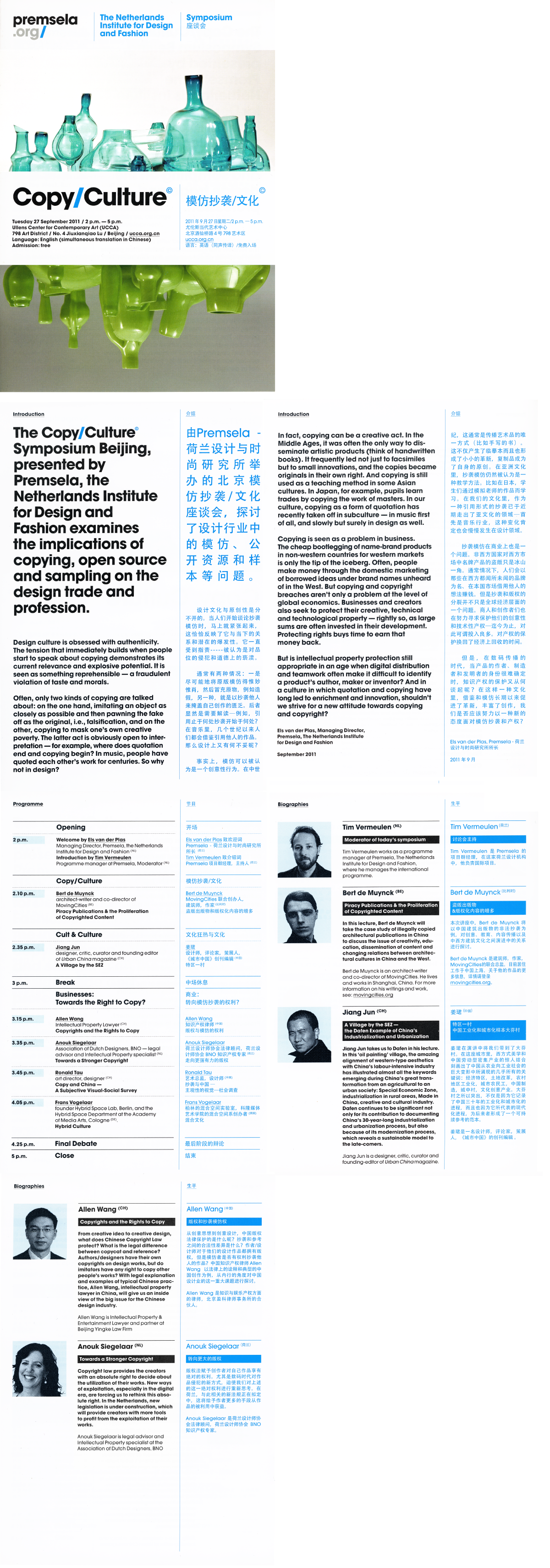The Copy/Culture® Symposium Beijing, presented by Premsela, the Netherlands Institute for Design and Fashion examines the implications of copying, open source and sampling on the design trade and profession.
Lecture @ Copy/Culture Symposium, Premsela, The Netherlands Institute for Design and Fashion, Beijing, 11 September 2011
Design culture is obsessed with authenticity.
The tension that immediately builds when people start to speak about copying demonstrates its current relevance and explosive potential. It is seen as something reprehensible — a fraudulent violation of taste and morals.
Often, only two kinds of copying are talked about: on the one hand, imitating an object as closely as possible and then pawning the fake off as the original, i.e., falsification, and on the other, copying to mask one’s own creative poverty. The latter act is obviously open to interpretation – for example, where does quotation end and copying begin? In music, people have quoted each other’s work for centuries. So why not in design?
In fact, copying can be a creative act. In the Middle Ages, it was often the only way to disseminate artistic products (think of handwritten books). It frequently led not just to facsimiles but to small innovations, and the copies became originals in their own right. And copying is still used as a teaching method in some Asian cultures. In Japan, for example, pupils learn trades by copying the work of masters. In our culture, copying as a form of quotation has recently taken off in subculture — in music first of all, and slowly but surely in design as well.
Copying is seen as a problem in business.
The cheap bootlegging of name-brand products in non-western countries for western markets is only the tip of the iceberg. Often, people make money through the domestic marketing of borrowed ideas under brand names unheard of in the West. But copying and copyright breaches aren’t only a problem at the level of global economics. Businesses and creators also seek to protect their creative, technical and technological property – rightly so, as large sums are often invested in their development. Protecting rights buys time to earn that money back.
But is intellectual property protection still appropriate in an age when digital distribution and teamwork often make it difficult to identify a product’s author, maker or inventor? And in a culture in which quotation and copying have long led to enrichment and innovation, shouldn’t we strive for a new attitude towards copying and copyright?
Programme
14.00 Opening
Welcome by Els van der Plas
Managing Director, Premsela, the Netherlands Institute for Design and Fashion (NL)
14.05 Introduction
Tim Vermeulen, Programme manager at Premsela, Moderator (4)
14.10 Piracy Publications & the Proliferation of Copyrighted Content
Bert de Muynck architect-writer and co-director of Moving Cities (BE)
14.35 Cult & Culture
Siang Un, designer, critic, curator and founding editor of Urban China magazine (CH) A Village by the SEZ
15.15 Businesses: Towards the Right to Copy? Copyrights and the Rights to Copy
Allen Wang, Intellectual Property Lawyer (CH)
15.35 Towards a Stronger Copyright
Anouk Siegelaar, Association of Dutch Designers, BNO — legal advisor and Intellectual Property specialist (NL)
15.45 Copy and China – A Subjective Visual-Social Survey
Ronald Tau, art director, designer (CH)
16.05 Hybrid Culture
Frans Vogelaar, founder Hybrid Space Lab, Berlin, and the Hybrid Space Department at the Academy of Media Arts, Cologne (DE).
16.25 Final Debate
17.00 Close
related PRESS
